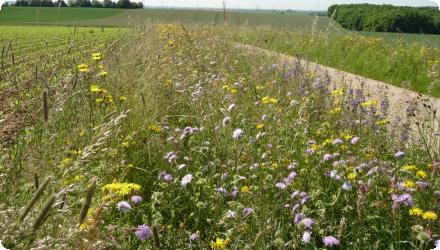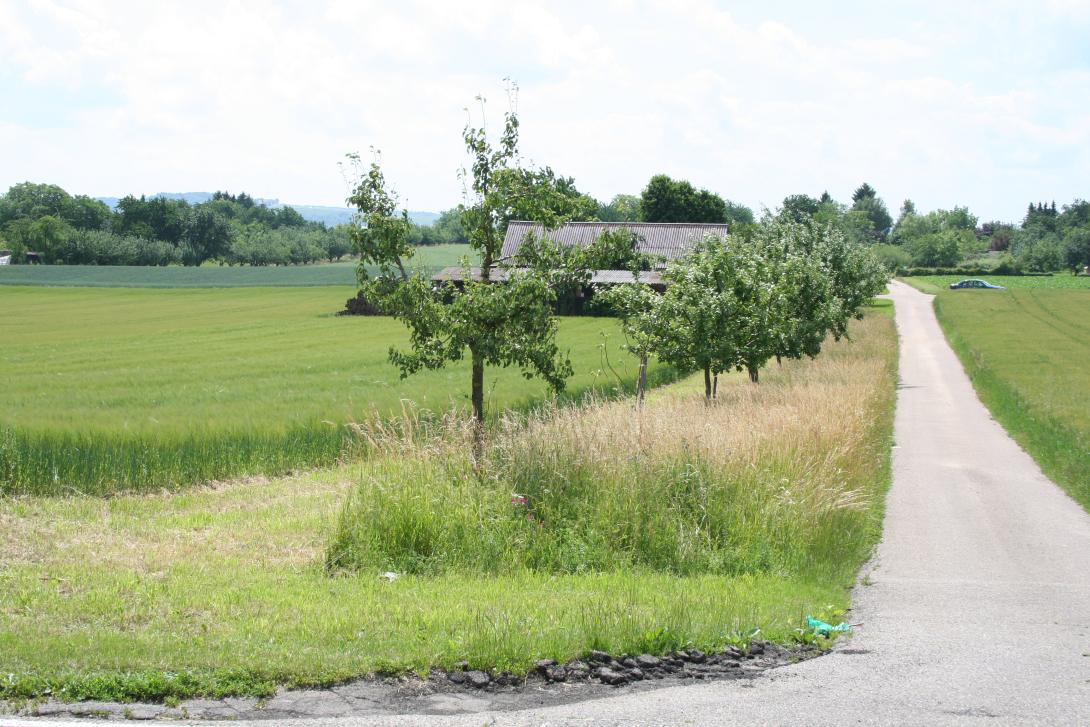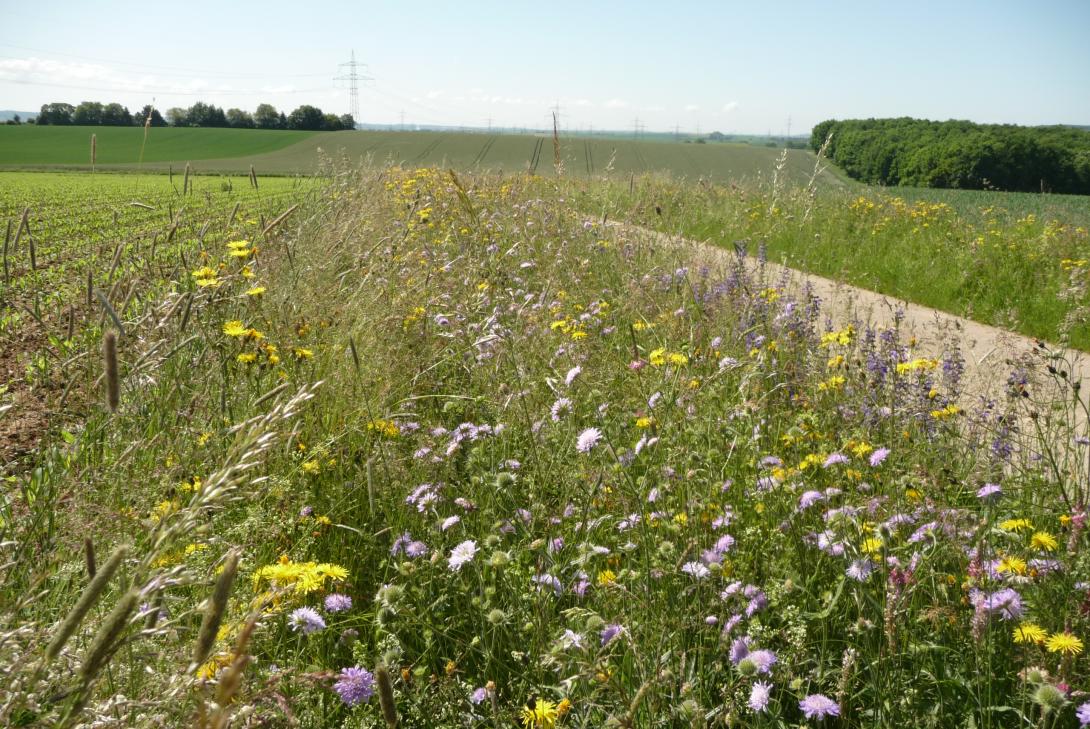Last update
2025
Summary
Since 1992, the city of Heilbronn (Germany) has implemented a field margin programme to reduce erosion, improve water infiltration, and promote biodiversity in the agricultural landscape. Farmers receive compensation for yield losses and maintenance work. The programme includes various strip types, such as grasslands, hedgerows, and orchard rows, planned according to local soil and biodiversity maps. Recent efforts highlight synergies with education (school orchards), pollinator protection, and landscape aesthetics. The initiative is embedded in the city’s ecological corridor strategy and contributes to soil, water, and habitat conservation.
So far, it has been found that the field margins have a significant positive impact on soil erosion and species composition. The partridge protection strips in particular have had a positive effect on the partridge population.
The project has grown over the last 30 years in terms of area and number of contractual partners. Although some contractual partners withdrew a few years ago, the area has not changed significantly. New applications for new areas are still recieved.
So far, it has been found that the field margins have a significant positive impact on soil erosion and species composition. The partridge protection strips in particular have had a positive effect on the partridge population.
The project has grown over the last 30 years in terms of area and number of contractual partners. Although some contractual partners withdrew a few years ago, the area has not changed significantly. New applications for new areas are still recieved.
Position
Latitude
49.14
Longitude
9.21
Project
NWRM
National Id
Germany_01
Installation date
1992
Implementation Status
Contact
Guillaume Michel, ACTeon
RBD code
DE2000
Transboundary
0
Photo gallery
Location of the project
Over the territory of the Heilbronn municipality.
NUTS Code
DE11 - Stuttgart
Project's objectives
The original objectives were to promote segetal flora and fauna and to reduce erosion through improved soil retention.
Involved Partners
| Authority type | Authority name | Role | Comments |
|---|---|---|---|
Climate zone
cool temperate moist
Temperature
9,9
Precipitation
758
Annual rainfall range
900 - 1200 mm
Elevation range
159 m
Vegetation class
Grassland (Heilbronn meadow seeds for fertile soils)
Water bodies: Ecological Status
Poor
Water bodies: Chemical Status
Failing to achieve good
Project scale
Meso
Project scale specification
The project is limited to the municipality of Heilbronn's territory.
Project area
72,87 ha, 1.906 field margins, 80 contractual partners
Lifespan
The field margin support measures will be renotified and reapproved over a five-year period. The program will continue without any time limits.
The project was launched as part of the cooperation and in the interests of sustainability (soil protection, species protection).
Field margins (size, localization...) have been designed taking into account the ways of water runoff, soils types, slopes, etc.
The greatest restrictions and, at the same time, the most favorable conditions all depend on cooperation with local farmers. Overall, the majority of the community has supported this project, and it is progressing steadily. The biggest difficulties so far have been that individual citizens have complained about the extensive mowing (“untidy condition”) or that individual contractors had special financial requests and have withdrawn from the project as a result. Furthermore, it is not easy to attract new contractors to this project.
Total cost
140000
Costs total information
In the budget of the Heilbronn Municipality, 140 000 €/year are dedicated to the Field Margins Programme.
Financing authorities
Type of funding
Local funds
Comments
The "Ackerrandstreifprogramm" (Programme for field margins) is a programme of subsidies for farmers concerned by a loss of their revenues due to the implementation of field margins. Subsidies are based on the amount of the variable cost margin. The amount of subsidies is defined in directives (from the municipality).
140 000 €/year from the municipality. The municipality is the only financer (no funds from the Land, the Federal state or the EU).
140 000 €/year from the municipality. The municipality is the only financer (no funds from the Land, the Federal state or the EU).
Compensations
1
Compensations basis information
601 €/ha + a variable part depending on type of field margin
Compensations nr beneficiaries
94
Compensations nr beneficiaries information
94 farmers or land owners are concerned by the programme
Compensations scheme information
One part of the payments aims at compensating the reduced gross margin (601 €/ha). The second part depends on the type of field margin. It is designed in order to cover costs linked to the care of field margins. From 2011 onwards, total costs are:
- Field margins: 1250 €/ha + seeds
- Field margins (fallow land): 1170 €/ha
- Field margin with a row of trees: 1740 €/ha + trees
- Field margins with an hedge: 2900 €/ha + plants
- Field margins: 1250 €/ha + seeds
- Field margins (fallow land): 1170 €/ha
- Field margin with a row of trees: 1740 €/ha + trees
- Field margins with an hedge: 2900 €/ha + plants
Policy context
Since the start of the field margins programme of the Heilbronn municipality in 1992, about 200 km of field margins have been managed. In this program, a large place is reserved for the involvement of farmers in all stages including the design phase. A compensation scheme targeting farmers and land owners has been designed by the municipality and its partners in accordance with the European legislation on agricultural subsidies.
Land ownership
Field margins are implemented on privately owned agricultural land.
Community involvment
Yes
Design consultation activity
| Activity stage | Name | Key issues | Comments |
|---|---|---|---|
|
Design phase
|
Cooperation with farmers and land owners
|
Cooperation with farmers and land owners took place during the planning and design phase through meetings and field meetings as well as discussion with groups or individual farmers.
|
|
|
Implementation phase
|
Exhibition about the field margin programme
|
||
|
Numerous articles in the press, radio interviews...
|
Policy target
| Target purpose |
|---|
|
Erosion Control
|
|
Runoff control
|
|
Oher Societal Benefits
|
Policy pressure
| Pressure directive | Relevant pressure |
|---|
Policy impact
| Impact directive | Relevant impact |
|---|
Requirement directive
| Requirement directive | Specification |
|---|
Contractual arrangements
1
| Arrangement type | Responsibility | Role | Name | Comments |
|---|---|---|---|---|
|
Contractual agreement
|
Farmers must apply before planting (spring or autumn), with detailed maps and dimensions. Farmers must follow ecological mowing dates, avoid fertilisers/pesticides, and maintain the strips.
|
Agreement between the municipality and the farmers about management rules of field margins.
|
"Pflegeconzept"
|
Contracts last 5 years (exceptions possible for 1 year in transition phases). 9 different margin types (e.g., grass strips, hedgerows, orchard rows). Annual monitoring and documentation; non-compliance leads to funding cuts or repayment.
|
|
Institutional arrangement
|
Notification of the program at the European Commission
|
Subsidies to farmers have to bi notified to the European Commission
|
Part of wider plan
1
Wider plan type
| Wider plan type | Wider plan focus | Name | Comments |
|---|---|---|---|
|
Local
|
Agriculture
|
Agro-environmental programme of Heilbronn
|
The Agro-environmental programme of Heilbronn has been approved by the European Commission in 2010 until 2013. For the next period 2014-2020, a new notification to the European Commission has been made under the same conditions than before.
The EU has approved the program after prolonged procedures. However, the EU does not grant co-financing. The cities of Heilbronn, Ludwigsburg and Bietigheim-Bissingen finance their agri-environment schemes to 100%. |
No studies have been conducted on these areas to date.
The areas are inspected on a random basis by the Parks Department.
Maintenance
By farmers. Depends on the measure type, ranges from mulching or mowing twice a year, hedge maintenance, tree maintenance, cultivating, sowing and reseeding, to various combinations and special forms (e.g., partridge protection strips with fallow strips).
Strong links with public engagement projects (e.g. school orchard juice, biodiversity trail). Educational and demonstration functions included (KommBio.de)
Long-term benefits through reduced soil degradation and better agricultural resilience.
The sudden withdrawal of some contractual partners in 2020 was unexpected, resulting in the loss of some field margins.
Runoff reduction
20
Runoff reduction unit
% Percent
Peak flow rate reduction
Buffer strips help slow down surface water during heavy rainfall, mitigating flood peaks
Information on Increased infiltration
Improved rainwater infiltration and groundwater recharge through deep-rooted grasses and worm activity.
Ecosystem erosion control
Reduced erosion and sediment runoff near water bodies.
1
Field margins are designed in order to promote biodiversity.
The density of earthworms in field margins has been improved (about twice more earthworms in field margins than in the neighbouring field).
Habitat for species like yellow wagtail (Schafstelze), grey partridge, bumblebees, butterflies.
Rich mix of native herbs, grasses, and fruit trees supports pollinators and bird species.
Linked with broader biotope network plans (Biotopverbundkonzept)
The density of earthworms in field margins has been improved (about twice more earthworms in field margins than in the neighbouring field).
Habitat for species like yellow wagtail (Schafstelze), grey partridge, bumblebees, butterflies.
Rich mix of native herbs, grasses, and fruit trees supports pollinators and bird species.
Linked with broader biotope network plans (Biotopverbundkonzept)
Ecosystem provisioning services
1
Information on Ecosystem provisioning services
Some rows of fruit trees and wood trees have been planted in the field margins. They provide wood and fruits.
Key lessons
The Heilbronn municipality highly recommends implementing this easily achievable project on other agricultural land in other cities. It promotes biodiversity, soil quality, and relationships with farmers. Promoting biodiversity on farmland is highly recommended, as it is increasingly being lost globally due to modernization and land expansion.
Success factor(s)
| Success factor type | Success factor role | Comments | Order |
|---|---|---|---|
|
Communication activities
|
main factor
|
Close relationship of trust between farmers and the municipality (particularly the administration for green areas which coordinates the program). This is helped by the areas on which the program is implemented (Heilbronn = a small territory, farmers in Heilbronn work only in Heilbronn, etc.).
|
1
|
|
Attitude of decision makers
|
main factor
|
Elected representatives in Heilbronn agree on this program. There is therefore a very limited risk of no financing.
|
2
|
|
Attitude of the public
|
main factor
|
Field margins helped decreasing conflicts between inhabitants and farmers. The public supports hence the program.
|
3
|
|
Attitude of relevant stakeholders
|
main factor
|
Field margins helped decreasing conflicts between inhabitants and farmers. Farmers support therefore the program.
|
4
|
|
Financing possibilities
|
main factor
|
Farmers are paid in order to compensate the decrease of crops.
|
5
|
Driver
| Driver type | Driver role | Comments | Order |
|---|---|---|---|
|
Availability of subsidies
|
secondary driver
|
According to the directive of the municipality concerning the Field Margins Programme : Funding will be provided as long as the municipal budget allows it.
|
1
|
|
Other
|
secondary driver
|
The ease of implementation
|
|
|
The willingness of many farmers to participate in this project
|
Transferability
This project can be easily implemented at any location with farmland.
Basin characteristics influence
This project has benefited above all from the surrounding fields and field margins, as some species of segetal flora typical of the location have been able to recover in many places.
Cost effectiveness
A precise cost-benefit analysis has not yet been carried out. However, it can be said that the benefits were very high and the associated costs and effort were comparatively low. This project is very effective in terms of erosion and biodiversity.
English




The Municipality establishes directives which define the rules of the Field Margins Programmes